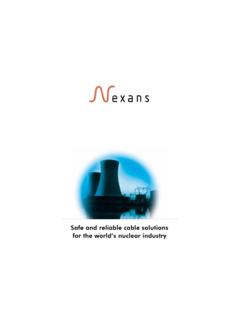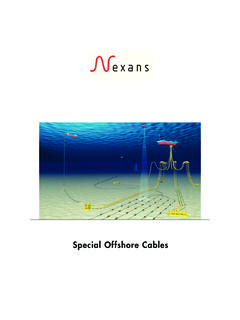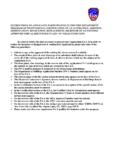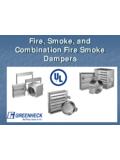Transcription of Fire Resistance and Safety in Case of Fire - Nexans
1 F. Gyppaz Nexans Research Center Lyon France - +33 4 37 37 47 47 Page 1/12 2014/03 fire Resistance and Safety in case of fire Franck GYPPAZ Nexans Research Center April 2014 F. Gyppaz Nexans Research Center Lyon France - +33 4 37 37 47 47 Page 2/12 2014/03 Table of content 1 Introduction .. 3 2 fire development .. 3 Ignition .. 3 Growth or 4 Full development .. 4 Decay .. 4 3 fire Resistance and cable technology .. 5 4 Cable fire Resistance assessment .. 6 5 CR1 .. 11 6 Conclusion.
2 12 F. Gyppaz Nexans Research Center Lyon France - +33 4 37 37 47 47 Page 3/12 2014/03 1 Introduction One minute after a fire ignites, it is generally said that only one water glass is needed to extinguish it. After two minutes, one pail of water is needed, and after three minutes, the fire is out of control. Only firefighters or well-trained people can act to contain the disaster. Bearing this in mind, it is crucial to have the possibility of escaping the building as quickly as possible.
3 In this event, pre-planned fire - Safety strategy is paramount. Flame, fire , smoke detectors can be installed in all areas to alert people and allow their escape during the first stage of a fire . But for a well-developed fire , smoke is released and can reduce visibility. To remedy this, EXIT signs are used to help people find their way out. In addition, blinding and choking smoke is extracted via smoke exhaust systems. In all cases, the devices will have to be connected to the electrical system.
4 The usual way is to use fire -resistant cable to enable electrical continuity even in extreme fire conditions. This White Paper aims to show how fire -resistant cables work, as well as to explain how their reliability and robustness impact on Safety . 2 fire development Generally speaking, the spread of fires in buildings follows four different stages of development, as showed here. Figure 1: fire development Ignition The fire triangle (see Figure 2) illustrates the fire principle. To start burning, three different elements are necessary at the same time, in just the right proportion.
5 They are heat, fuel and an oxidizing agent, usually oxygen. However, in flats, offices, two of them are always present. Flash overStart of fire &propagationFire extinction and escape possibleFire fully developedTemperatureTimeRoleof fireresistanceIgnitionRoleof firereactionF. Gyppaz Nexans Research Center Lyon France - +33 4 37 37 47 47 Page 4/12 2014/03 Figure 2: fire triangle The fuel consists of all of the materials: the furniture, computers, paper, combustible liquids, etc. Air brings the necessary oxygen into the room.
6 In air, the oxygen content is Finally, only a simple spark or flame is missing to trigger the infernal process. This could occur because of a short circuit due to an electrical device malfunction or external events ( fire in a garbage can, cigarette, etc.). Growth or propagation Finally, the fuel is heated to a temperature at which it starts to decompose and release gaseous products. They diffuse into the flame, and undergo combustion in the gas phase, liberating more heat. Under steady-state burning conditions, heat is transferred back to the fuel surface, producing more volatile polymer fragments to sustain the combustion cycle.
7 The overall temperature in the room increases and the fire continues to grow. By convection, the hot gases or particles ignite other items in the room. The pressure increases, and gases try to escape via openings igniting other fire sources. Furthermore, depending on the building construction thermal conductivity, a significant amount of energy can be transferred from one room to another increasing the likelihood of fire propagation. The higher the thermal conductivity, the higher the risk. Full development In the case of a closed room, a flashover may occur if the overall temperature is high enough (500-600 C), with sufficient oxygen content.
8 There is a sudden transition from a growth stage to a fully developed fire with a total surface involvement of all combustible materials. The internal pressure becomes huge in the enclosed space, leading to a possible explosion and aperture openings. At the same time, the heat released is at its maximum, and hot gases (as well as flames) can propagate far away from the starting point. Finally the fire spreads from one room to another following the same cycle, and conditions quickly threaten life and infrastructure.
9 Decay When the combustible material and/or the oxygen contents are not high enough to sustain the fire cycle, the fire starts to decay. This is obviously a good sign that the fire will stop soon. Nevertheless, it may be a trap. F. Gyppaz Nexans Research Center Lyon France - +33 4 37 37 47 47 Page 5/12 2014/03 Decay begins when the oxygen content is not high enough to sustain fire combustion. The heat released decreases, but the temperature can still increase for some time. Hot combustible particles and gases are still produced and can burst into flame again if fresh air arrives in the environment.
10 3 fire Resistance and cable technologies During the first stage of a fire , the basic idea is to stop or reduce as much as possible its propagation and make possible fire extinguishment. At the same time, it ensures that people can be evacuated under safe conditions. Nexans has developed various fire -retardant systems, and proposes many of them under the trademark, ALSECURE , for building applications. When the fire is out of control, the situation becomes critical. It propagates quickly, releasing intense heat, opaque smoke and toxic substances, which drastically limit the possibility of escape.

















